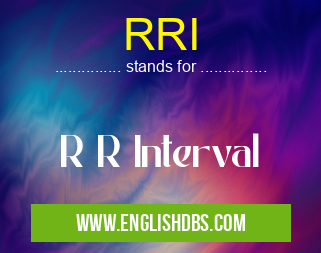What does RRI mean in UNCLASSIFIED
RRI (R R Interval) is a measure of the time between the peaks of successive R waves on an electrocardiogram (ECG). It represents the time taken for the electrical impulse to travel from the sinoatrial node (SA node) to the ventricles and back to the SA node.

RRI meaning in Unclassified in Miscellaneous
RRI mostly used in an acronym Unclassified in Category Miscellaneous that means R R Interval
Shorthand: RRI,
Full Form: R R Interval
For more information of "R R Interval", see the section below.
Importance of RRI
The RRI is an important indicator of heart rate and rhythm. It can help diagnose various cardiac conditions, including:
- Bradycardia: Slow heart rate (less than 60 beats per minute)
- Tachycardia: Fast heart rate (more than 100 beats per minute)
- Arrhythmias: Irregular heartbeats
Assessment of RRI
The RRI is typically measured in milliseconds (ms). Normal RRI values vary depending on age, sex, and activity level. However, a resting RRI of 600-1000 ms is generally considered normal.
Interpretation of RRI
- Shortened RRI (less than 600 ms): Can indicate tachycardia or premature ventricular contractions.
- Prolonged RRI (more than 1000 ms): Can indicate bradycardia or atrioventricular block.
- Variable RRI: Can indicate atrial fibrillation or other arrhythmias.
Essential Questions and Answers on R R Interval in "MISCELLANEOUS»UNFILED"
What is RRI?
RRI stands for R-R Interval, which is the time between two consecutive R waves on an electrocardiogram (ECG). It represents the duration of one cardiac cycle and is used to measure heart rate and rhythm.
How is RRI measured?
RRI is typically measured using an ECG machine, which records the electrical activity of the heart. The machine automatically detects and measures the time between successive R waves, providing an accurate measurement of RRI.
What is a normal RRI?
A normal RRI for adults at rest ranges between 600 and 1,000 milliseconds (ms). However, it can vary slightly depending on age, activity level, and other factors.
What does an abnormal RRI indicate?
An abnormally short or long RRI can indicate various heart rhythm disorders. For example:
- A short RRI (less than 600 ms) may suggest a rapid heart rate (tachycardia) due to conditions like atrial fibrillation or ventricular tachycardia.
- A long RRI (more than 1,000 ms) may indicate a slow heart rate (bradycardia) caused by conditions like sinus node dysfunction or heart block.
How is RRI used clinically?
RRI is a crucial parameter used in clinical practice to:
- Calculate heart rate and monitor rhythm in real-time.
- Diagnose and differentiate various arrhythmias.
- Guide treatment and management of heart conditions, such as the use of pacemakers or medications.
Final Words: The RRI is a valuable tool for assessing heart rate and rhythm. By measuring the time between R waves, healthcare professionals can identify and diagnose various cardiac conditions. Regular monitoring of RRI is essential for maintaining optimal heart health.
